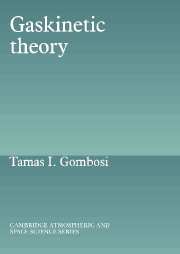1 - Introduction
Published online by Cambridge University Press: 16 September 2009
Summary
The objective of gaskinetic theory is to explain and predict the macroscopic properties of gases from the properties of their microscopic constituents. Macroscopic properties include the equation of state, specific heats, transport coefficients (such as viscosity, diffusion coefficient, thermal conductivity), etc. The fundamental hypothesis of kinetic theory is that solids, liquids and gases are composed of finite particles (molecules) which are in various states of motion. The term molecule is taken generally to mean a regular arrangement of atoms, or it may refer to a free, atom, an electron or an ion.
Statistical mechanics, like kinetic theory, also aims to explain and predict the macroscopic properties of matter in terms of the microscopic particles of which it is composed. The main difference between gaskinetic theory and statistical mechanics is the manner in which particle interactions are treated. In gaskinetic theory the details of the molecular interactions are taken into account. Statistical mechanics avoids these complicated and sometimes poorly known details and replaces them with certain powerful and general statistical ideas.
Brief history of gaskinetic theory
The history of the kinetic theory of gases can be traced back to ancient Greece, where around 400 B.C. Democritus hypothesized that matter is composed of small indivisible particles which he called atoms. The atoms of different materials were assumed to have different sizes and shapes, so that atoms represent the smallest quantity of a substance that retains its properties.
- Type
- Chapter
- Information
- Gaskinetic Theory , pp. 1 - 14Publisher: Cambridge University PressPrint publication year: 1994

